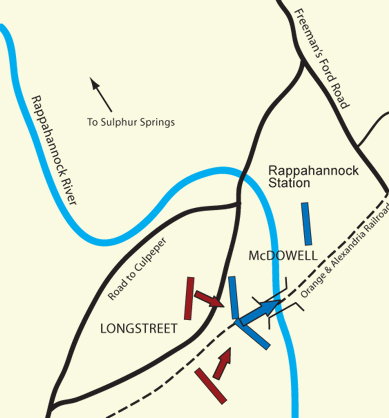Introduction
Spring 1862: Following his strategic victory in the Peninsula Campaign, Confederate General Robert E. Lee worried that two armies, under Union Generals George McClellan and John Pope, would combine their forces for a major offensive against his own. Together, McClellan’s troops, east of Richmond, Virginia, and Pope’s forces, concentrated at Culpeper, Virginia, would pose a serious threat to Lee’s army.
Seizing the initiative, Lee moved his army north to attack Pope before he could unite with McClellan. Before engaging portions of Pope’s army along the Rappahannock River and in the Bull Run Mountains, Lee’s advance troops, under General Thomas “Stonewall” Jackson, defeated a smaller Union force at Cedar Mountain on August 9. These relatively small but important actions pushed Pope’s army further from McClellan’s and allowed the Confederate generals to converge on Pope near the old Manassas battlefield, where the armies had clashed in 1861.
At the Second Battle of Manassas, August 28-30, Lee achieved an overwhelming victory which prompted Pope’s hasty withdrawal towards Washington. Although a Confederate turning movement failed at the Battle of Chantilly on September 1, the door had been opened for Lee’s first invasion of the North—an invasion that ended at the Battle of Antietam.
1st Battle Of Rappahannock Station
Date: August 23, 1862
Result: Inconclusive
Troops Engaged: 2,000 US; 2,500 CS
Casualties: 172 US; 53 CS
On the morning of August 23, Pope learned that Jackson and his men were on the north bank of the Rappahannock River at Rappahannock Station, attempting to cross at Sulphur Springs. Heavy rains made the river impassible at this point and the confederates remained isolated from the main body of their force.
Recognizing the opportunity, Pope planned to attack Jackson’s troops at Sulphur Springs. He ordered McDowell’s Corps, which was in position on the south side of the river at Rappahannock Station, to cross the river and prevent a Confederate withdrawal by destroying their route—the railroad bridge.
Before McDowell could act, however, Lee ordered General James Longstreet to push the Federals back to the north side of the river. Two hours of Confederate artillery bombardment failed to dislodge McDowell’s men, so Longstreet called on his infantry. As Longstreet’s men approached the base of the Federal position on a knoll, their opponents retreated down the opposite slope and over the railroad bridge. Once atop the knoll, Confederate soldiers took fire from Union troops, which had already safely crossed over to the north bank of the Rappahannock. Fire was so heavy that the Confederates were forced to fall back and seek cover. Likewise, at Sulphur Springs, pressure from an offensive launched by Pope forced Confederate engineers to construct a bridge across the Rappahannock so that Jackson’s forces could retreat to the south side of the river. Thus, while the battle of Rappahannock Station resulted in little tangible gain for Confederate forces, the conflict did help set the stage for one of Lee’s greatest victories.
RAPPAHANNOCK STATION TODAY
Rappahannock Station (today’s Remington) was the site of two separate battles, both involving the railroad and the Rappahannock River. The first of these engagements occurred over the Orange & Alexandria Railroad bridge. Although Union soldiers burned the bridge during the battle, stone piers from the bridge can still be seen on both banks of the river, and the railroad — now the Norfolk Southern — still runs through town today.

